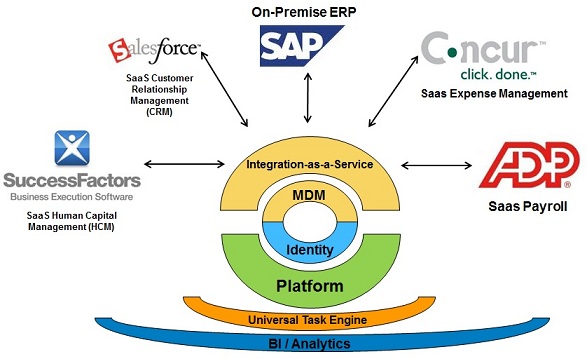For the last two years a colleague of mine Scott Skellenger (Sr. Director of IT for Illumina) has been professing that the next generation business suite won’t be a traditional suite at all. He has been carefully watching the integration-as-a-service market and believed that the new world of business applications will be where business units will seek business function-as-a-service solutions (LoB). Then IT’s role will be to manage integration and master data.
At the time of our first discussions, I had completed implementing a true SaaS ERP platform for the company where I managed their IT. In that model, the SaaS ERP was the center of the universe and a platform-as-a-service wrapped the solution to provide any customized functionality or workflow needed. 3rd party solutions could also interface directly with that solution.
I was fortune because I was provided a greenfield, to rip and replace all systems and restructure the business’s operations. So for me this was the ultimately path forward for using cloud solutions to manage a business’s operations. Given the fact that it was a mid-sized manufacturing company, I could assemble the executives of the company who really understood their respective business processes and collectively work through the end-to-end process changes that the new system would introduce.
What Scott understood very well back then (and I wasn’t quite seeing) was that in the large enterprise, there was going to be very little opportunity to rip and replace existing ERP suites. Process is understood farther down the org chart, and those business units drove the innovation in their areas, not the topline executives.
As it seems Scott wasn’t the only one who understood this. Lines of Business cloud providers understand this very well also. They understand this because when they want to sell their solutions to a large enterprise, they no longer worry about talking to the CIO. They go right to heads of the business unit and leave IT out the discussion.
So what will the large enterprise IT organizations do? It seems that they need to find a way to become relevant again. So the challenge is one part architectural, one part organizational and a rethink to become service oriented.
The Architecture
For the last 6 months I’ve been thinking about this more, my thoughts returned to this idea of the integration-as-a-service. It became clear that more would be required. Integration-as-a-Service would provide process integration between SaaS solutions and with existing internal application services. It would also provide Master Data Management (MDM).
Public cloud offerings create a borderless computing model. The result is that the only way to properly secure those assets is to tightly manage the identities that have access. So IT will need to use an Identity-as-a-Service provider to manage identity federation with all SaaS services.
Now that data is being normalized through the integration translation layer. There is the opportunity to have a centralized Platform-as-a-Service environment to develop point solutions and workflows. This is significant change of model. Because now the PaaS is the center of the universe and the many different SaaS services surround the PaaS. It would be very important that this platform be built with open standards. That way if an enterprise desires to change platforms, the solutions that were coded are portable. Having no vendor lock-in is critical here.
Having BI/Analytics layer goes without saying. To be able to report on transactional and master data produced across SaaS and PaaS environments is critical for future strategy formation and operational improvements.
Because we are no longer working with a classically integrated suite, we are missing a critical piece of data which in the SAP world is referred to as Document Flow. We are also missing business context for the end user. If we have many different SaaS solutions, the end user potentially has no context for knowing when to engage one service or the other. There needs to be a portal much like a BPM where process is defined across the many different SaaS and internal applications. As a process is being fulfilled you can track each step and reference the documents related to each step completed. Along with that process mapping, a Universal Task Engine needs to be available to direct users to the correct SaaS service and fulfill whatever task is required of them.
In total, I’m referring to this solution set as the “Enterprise Cloud Core”. More recently, I had a chance to reconnect with Scott and we discussed this Cloud Core concept. As it turns out he has been already presenting a similar concept in industry cloud summits (no surprise Scott is a thought leader in the space). He refers to this as “Cloud Orchestration”. Whatever name you want to give it, it represents the go forward strategy of the large enterprise. What Scott and I were pondering was why no one in the industry was putting a stake in the ground and announcing their desire to offer a Cloud Core. This is a huge opportunity in the industry, if someone gets it right.
Yesterday, I was following a post in Linkedin by Sven Denecken, VP Cloud Solutions SAP. It was in reference to an article by a partner regarding SAP’s recent Netweaver Cloud offering. http://bit.ly/LLkT9C There it very well described a platform that is more than a development environment. It’s the beginning of SAP’s Cloud Core.
When the kings of the business suite (SAP) are throwing down the gauntlet and talking up their Cloud Core, the industry needs to perk up and recognize the change that is coming. The traditional suite construct as we’ve known it, is dead (as we know it). There is no one left who should be confused about the direction of cloud solutions for the large enterprise. It is a perspective that Lars Dalgaard (now head of SAP’s Cloud Unit) had from his SuccessFactors days and is now paving the way forward to do at SAP. However with players like RedHat, VMware and the like working their way to a Cloud Core as well, we should see an explosion of activity in this space. The Cloud Core will represent IT’s next generation killer service for the business. Enterprises are tired of expensive vendor lock-in and this architecture provides the option to go all in with one vendor or piece together a solution with many to best fit the needs of the business.
More to follow regarding organizational changes to come under this new model.
(1023 Views)




